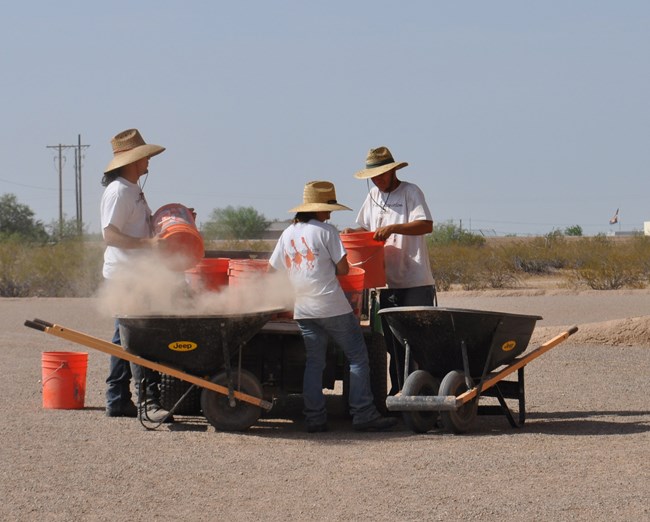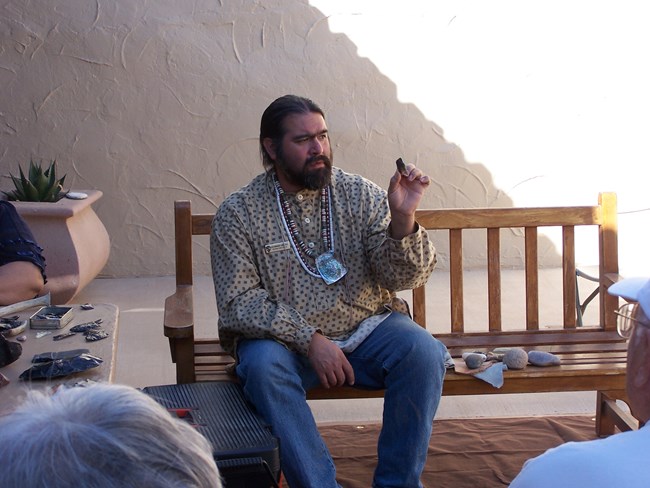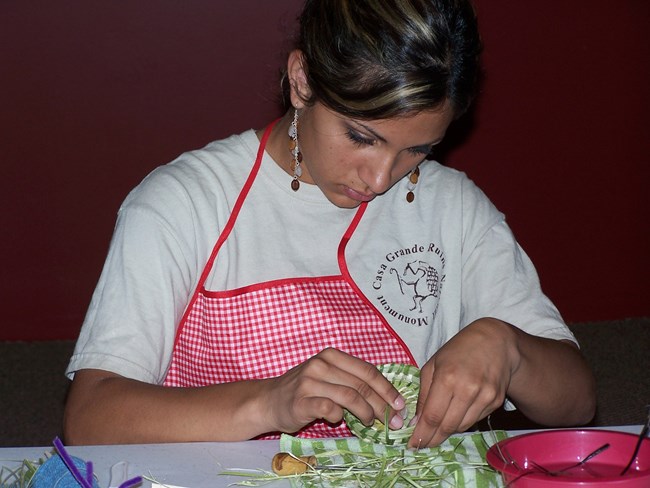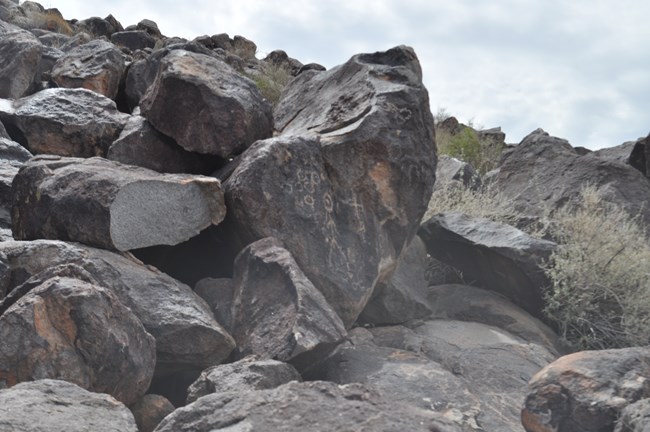|
Casa Grande Ruins National Monument is a great place for teens to visit, volunteer, and work. Teens are hired through the Youth Conservation Corps (YCC) or Native American Conservation Corps (NACC) for summer projects. The announcement for the jobs comes after (and if) the park receives a grant for a special projects. Sometimes the work is with the park maintenance division, other times it is working with the Cultural Resources group. Projects include hands-on work side by side with regular park staff plus special learning days to help teens gain real job skills and experience. Teens volunteer through other organizations, such as school, scout, or church groups. The park would be happy to have an Explorer Post started, we just need 6 or more interested teens.. The Explorer Post will learn about the park resources, create videos about things to see and do in the park, and do at least 50 hours of community service per year to earn a national leadership award. Teen visitors will most like the park's demonstration area. This is a hands-on place run by park volunteers and/or special guests so that park visitors come to appreciate the life of the ancestral Sonoran Desert people. Work at Casa Grande Ruins: 
NPS Here is Trevor's (YCC 2012) account of the work: The YCC summer program and NACC summer program were joined together this summer as a whole. We were handed a number of projects to complete by the end of the summer and it wasn't too easy. We had to backfill all around our Great House, which is layering dirt in all the bald spotted areas and leveling the ground, the crew had to do four layers! We also dealt with re-contouring disturbed areas around the new theatre, by that, I mean we planted native plants of the area, in our park. We also preserved all the walls around our Great House, which means we threw a mud-like texture on previously treated walls to keep them protected from harm's way. The smaller projects were just to keep the park clean and tidy, for the most part. Even with all these projects to be done and having to do them in 100°+ weather, we enjoyed ourselves with educational days and having special guests visit . We made pottery bowls, baskets, arrowheads, we were taught how to make a fire the old school way, and went to Tucson and harvested fruits off of Saguaro Cacti. Visit and Enjoy Casa Grande Ruins: 
NPS Demonstrations in the park visitor center courtyard are a new public offering. Rangers, park volunteers, and special guests demonstrate a wide variety of skills and objects. This is a new feature of the visitor center and should be of particular interest to teens. The demonstrations are hands-on presentations where participants may try their hand at a skill, or handle real artifacts and props. Past demonstrations included: flint knapping, shell jewelry making, beading, bead loom, flute playing, edible plants, and kids crafts. If you have a skill you would like to share with park visitors as a demonstrator please use the contact us links and let us know! 
NPS Sache (NACC 2012) has this to say about pottery making: Working at Casa Grande Ruins this summer I had the opportunity to make pots out of clay. We had, thankfully, Ron Carlos from the Salt River Indian Community come out to the park and share how to make them. I didn't know what to expect. At first Mr. Carlos showed us how to crush up the clay because it looked like normal size rocks. He had us crush the rocks down to powdery clay. We had to shift the powdery clay often to get rid of small rocks because rocks wouldn't work too well with making pots. Once the clay was processed, Mr. Carlos went over the different tools we were going to be using such as the flat paddles and rocks to smooth the pots. Mr. Carlos showed us the process to make a pot in the traditional manner, and without using a pottery wheel. Then the crew and I finally got to make our own pots. Some of them came out pretty good and let's just say some not so well. After the finished pots air dried we fired them in the traditional manner. 
NPS Rachel (YCC 2012) attended a basket making workshop in the park's new auditorium. Here's her account of what went on: NACC, YCC, staff, and park volunteers were lucky enough to have artists Dela and Fred Cruiz from Sells, AZ, come to the Casa Grande Ruins. We began our day with a traditional Tohono O'odham prayer, park visitors included, to ask our creator for patience. After the prayer, using pipecleaners we learned how to do the intricate knot that starts all baskets. Once we all had a good understanding of that we started working with the traditional materials. This includes bear grass, white and green yucca, and devil's claw. We had to pay close attention to learn, create, and build our baskets. Everyone soon got the hang of it and after several hours we all had completed our baskets. After seeing the outcome we all compared our artwork. We noticed that everyone's basket was different. It was as if they had their own personalities. This experience was most definately my favorite because it taught patience which gave me piece-of-mind and time to think. Volunteer and Gain Experience Explorer Post first meeting will be during the last week of September, 2013, in the park visitor center. The Casa Grande Post will be doing the hands on demonstrations and filming them for future podcasts and special uses. One day you may be able to use your smart phone to scan QR codes to see the behind-the-scenes stories of the park and "how to" stories of making tools and art in the ancient Sonoran Desert style. Explorers will take field trips, learn Native American cultural skills (flint knapping, basket making etc), and work with multi-media professionals such as newpaper editors, web designers, and photographers. Field Trips with Casa Grande Ruins Staff 
NPS Ana (YCC 2012) gives this account of a Picacho Rock Art Field Trip: One day some of the YCC and NACC went on a field trip to a mountain of petroglyph rock art by Picacho Peak. It was unlike anything I'd ever seen before. It looked like boulders stacked up into an immense pile, many with petroglyphs. There were all sorts of images etched into the rocks, ranging from rituals to animals. You could climb up the mountain to see more and more pictures on your way up. Some of them were thousands of years old! Unfortunately, in recent years the mountain has been vandalized and some rocks have been stolen. But that didn't take away from the joy we felt climbing to the top! 
NPS What is better than an educational field trip? An educational eating field trip! Rachel (YCC 2012) enjoyed this aspect of a trip to Sells and Topawa, Arizona to learn about the Tohono O'odham Nation. The town of Sells has an educational eatery! It is a non-profit cafe. Here is Rachel's trip report: One educational trip that we looked forward to taking went down to Sells, AZ. There we got to eat at the Desert Rain Cafe. They served traditional foods with a modern twist. These were the foods the Ancestral Sonoran Desert people would have eaten. The traditional ingredients in the foods included: Prickly pear cactus, tepary beans, agave nectar, mesquite flour, cholla buds, and more. Everything was healthy, low fat, low sugar, and natural but still tasty and refreshing. Personally, my favorite was the tea sweetened by the agave nectar and prickly pear. |
Last updated: September 19, 2015
